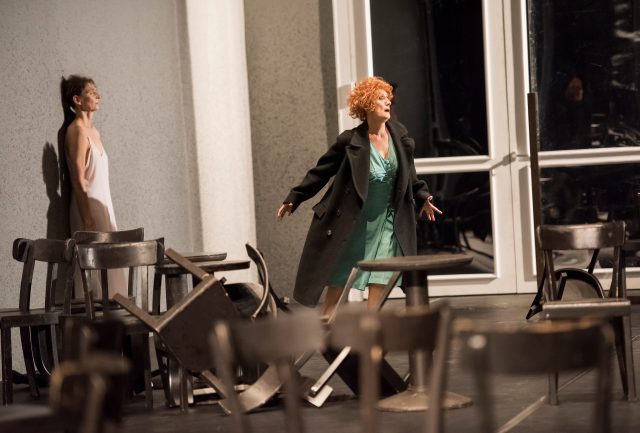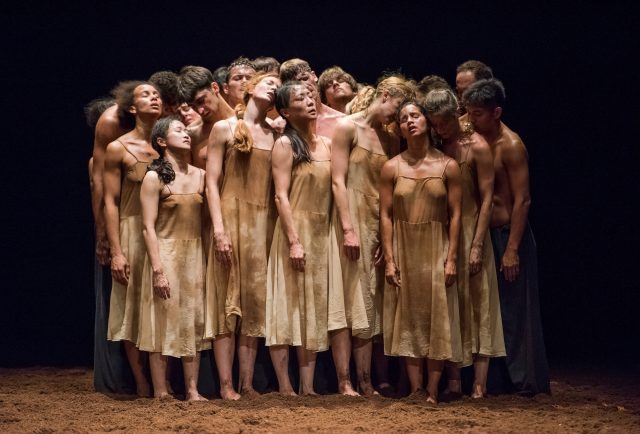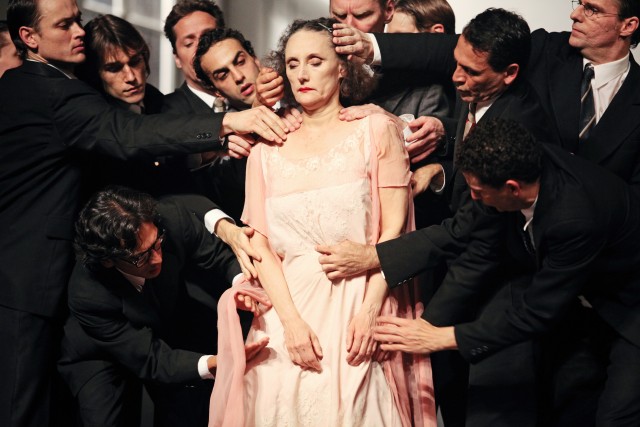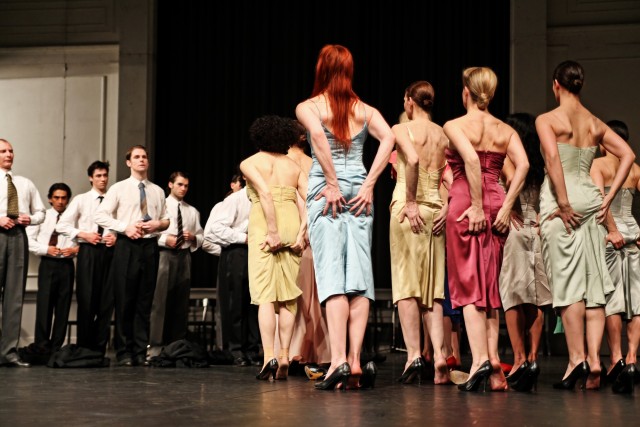
Helena Pikon evokes Pina Bausch herself as Nazareth Panadero searches for love in Café Müller (photo by Stephanie Berger)
NEXT WAVE FESTIVAL
BAM Howard Gilman Opera House
Peter Jay Sharp Building
230 Lafayette Ave.
September 14-24
718-636-4100
www.bam.org
www.pina-bausch.de/en
Tanztheater Wuppertal Pina Bausch goes back to the very beginning of its long relationship with BAM in its latest Next Wave Festival presentation, a double bill consisting of 1978’s Café Müller and 1975’s The Rite of Spring. The extraordinary works were first shown at BAM in the company’s Brooklyn debut in 1984 (with Bluebeard and 1980) and caused an immediate sensation. The evening opens with Café Müller, an autobiographical piece inspired by Bausch’s memories of the restaurant her parents owned in Germany. Rolf Bozik’s set is cluttered with wooden chairs and small tables, with a pair of large doors on either side and a rear exit leading outside. When Helena Pikon, in a long, off-white slip, her eyes closed, enters the space, it immediately brings to mind Bausch herself, who danced the role for nearly thirty years until shortly before her death in 2009 at the age of sixty-eight; from a distance, Pikon’s build and looks resemble Bausch’s, as if the legendary choreographer’s ghost is haunting the Howard Gilman Opera House. (Pikon alternates in the role with the much younger Breanna O’Mara, the first woman to dance the part who has never met Bausch.) Pikon moves ever-so-slowly, elegantly, as she leans against an unstable wall and lies on the floor. Another woman with eyes closed (Azusa Seyama) then rushes in as a man in a suit and wearing shoes furiously attempts to clear her path, tossing chairs and tables aside so she doesn’t bump into anything. Soon another barefoot man in a suit leads her to another man (Scott Jennings) with whom she forms a volatile relationship. Meanwhile, Nazareth Panadero, in heels and a red wig, meanders through the space, unable to find love. (Various roles are alternated nightly by Scott Jennings / Jonathan Frederickson, Panadero / Blanca Noguerol Ramírez, Michael Strecker / Michael Carter, and Seyama / Ophelia Young, along with Pau Aran Gimeno.) Set to emotive songs by Henry Purcell from The Fairy Queen and Dido and Aeneas, Café Müller is a beautiful lament, featuring repetition that often goes from lovely to frustrating to intoxicating. The magic continues through the intermission, as the audience can watch the stage crew transform the setting from the café to a rectangular mound of dirt for The Rite of Spring, earning its own well-deserved round of applause when they are finished.

Pina Bausch’s The Rite of Spring dazzles with thirty-two dancers performing on a dirt-covered stage (photo by Stephanie Berger)
Set to Igor Stravinsky’s classic score, Bausch’s The Rite of Spring is a force all its own, one of the most thrilling, heart-wrenching dances you’re ever likely to see. Sixteen bare-chested men in black pants and sixteen women in cream-colored dresses battle it out in groups that move in remarkable unison, at times intermingling, as a red dress, representing first sex, then death, is passed around, left in the middle of the floor by itself, and ultimately worn by Tsai-Chin Yu, who is pursued by Julian Stierle. The music soars as the company gets sweaty, the dirt sticking to their body and costumes, revealing the raw physicality of interaction. (The set and costumes are again by Borzik, Bausch’s partner from 1970 until his death ten years later at the age of thirty-five.) As in Café Müller, there is no talking; many of Bausch’s works feature spoken word, often for humor. But there’s no time for that in The Rite of Spring as the men take over one corner, the women another, then they circle each other, break off into couples, and focus on Yu, who performs a spectacular, convulsive solo of brutally intense emotion. The piece is like Jerome Robbins gone wild; the general setup might be traditional, at least for Bausch, the master of dance theater, but the movement is dazzling, a nonstop fury of arms and legs and bodies thrashing about and joining together. “There are situations, of course, that leave you utterly speechless,” Bausch once said. “All you can do is hint at things. Words, too, can’t do more than just evoke things. That’s where dance comes in.” Café Müller and The Rite of Spring helped establish her reputation, in Brooklyn and around the world, leaving fans and critics virtually speechless at her performances, save for the endless accolades afterward. Several decades later, and eight years after her passing, these works continue to expand her vast legacy.



 From 1973 until her death in 2009, legendary dancer and choreographer Pina Bausch ran Tanztheater Wuppertal, the German company that changed the face of dance theater forever with such seminal productions as Rite of Spring, Café Müller, Danzón, Masurca Fogo, and so many others, many of which had their U.S. premieres at BAM. In 1978 she staged Kontakthof, collaborating with Rolf Borzik, Marion Cito, and Hans Pop, set to music by Juan Llossas, Charlie Chaplin, Anton Karas, Sibelius, and other composers. In 2000, she revisited the piece with a cast of senior citizens, and eight years later she turned the roles over to a group of Wuppertal high schoolers, most of whom had never heard of her and had never danced before. Director Anne Linsel and cinematographer Rainer Hoffmann follow the development of this very different production in Dancing Dreams, speaking with the eager, nervous participants, who talk openly and honestly about their hopes and desires, as well as with rehearsal directors Jo-Ann Endicott and Bénédicte Billet, who do not treat the teens with kid gloves but instead are trying to get them to reach deep inside of themselves and hold nothing back. When Bausch shows up to choose the final cast, telling the teenagers that she doesn’t bite, the tension mounts. Dancing Dreams is an intimate look at the creative process, about dedication and determination and what it takes to be an artist. It suffers at times from feeling too much like a reality television show, mixing American Idol and So You Think You Can Dance with the fictional Glee, but it also offers a last glimpse at Bausch, whose final interview is captured in the film. “You might think I’ve had enough of Kontakhtof,” she says at one point. “But every time it’s a new thing.” Dancing Dreams is screening October 27 at 7:30 in conjunction with the current production of
From 1973 until her death in 2009, legendary dancer and choreographer Pina Bausch ran Tanztheater Wuppertal, the German company that changed the face of dance theater forever with such seminal productions as Rite of Spring, Café Müller, Danzón, Masurca Fogo, and so many others, many of which had their U.S. premieres at BAM. In 1978 she staged Kontakthof, collaborating with Rolf Borzik, Marion Cito, and Hans Pop, set to music by Juan Llossas, Charlie Chaplin, Anton Karas, Sibelius, and other composers. In 2000, she revisited the piece with a cast of senior citizens, and eight years later she turned the roles over to a group of Wuppertal high schoolers, most of whom had never heard of her and had never danced before. Director Anne Linsel and cinematographer Rainer Hoffmann follow the development of this very different production in Dancing Dreams, speaking with the eager, nervous participants, who talk openly and honestly about their hopes and desires, as well as with rehearsal directors Jo-Ann Endicott and Bénédicte Billet, who do not treat the teens with kid gloves but instead are trying to get them to reach deep inside of themselves and hold nothing back. When Bausch shows up to choose the final cast, telling the teenagers that she doesn’t bite, the tension mounts. Dancing Dreams is an intimate look at the creative process, about dedication and determination and what it takes to be an artist. It suffers at times from feeling too much like a reality television show, mixing American Idol and So You Think You Can Dance with the fictional Glee, but it also offers a last glimpse at Bausch, whose final interview is captured in the film. “You might think I’ve had enough of Kontakhtof,” she says at one point. “But every time it’s a new thing.” Dancing Dreams is screening October 27 at 7:30 in conjunction with the current production of 